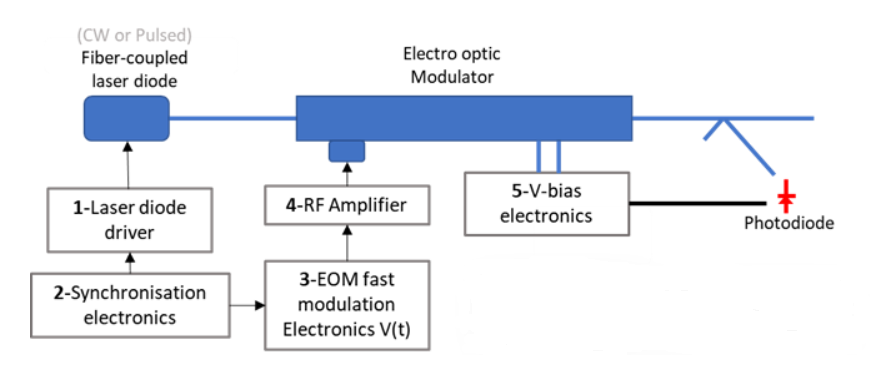Overview of four common modulators
This paper introduces four modulation methods (changing the laser amplitude in the nanosecond or subnanosecond time domain) that are most commonly used in fiber laser systems. These include AOM (acousto-optic modulation), EOM (electro-optic modulation), SOM/SOA (semiconductor light amplification also known as semiconductor modulation), and direct laser modulation. Among them, AOM,EOM,SOM belong to external modulation, or indirect modulation.
1. Acousto-optic Modulator (AOM)
Acousto-optic modulation is a physical process that uses acousto-optic effect to load information onto optical carrier. When modulating, the electrical signal (amplitude modulation) is first applied to the electro-acoustic transducer, which converts the electrical signal into ultrasonic field. When the light wave passes through the acousto-optic medium, the optical carrier is modulated and becomes an intensity modulated wave carrying information due to the acousto-optic action
2. Electro-optical Modulator (EOM)
An electro-optical modulator is a modulator that utilizes the electro-optical effects of certain electro-optical crystals, such as lithium niobate crystals (LiNb03), GaAs crystals (GaAs) and lithium tantalate crystals (LiTa03). The electro-optical effect is that when the voltage is applied to the electro-optical crystal, the refractive index of the electro-optical crystal will change, resulting in changes in the light wave characteristics of the crystal, and the modulation of the phase, amplitude, intensity and polarization state of the optical signal is realized.

Figure: Typical configuration of EOM driver circuit
3. Semiconductor Optical Modulator/Semiconductor optical amplifier (SOM/SOA)
Semiconductor optical amplifier (SOA) is usually used for optical signal amplification, which has the advantages of chip, low power consumption, support for all bands, etc., and is a future alternative to traditional optical amplifiers such as EDFA (Erbium-doped fiber amplifier). A semiconductor optical modulator (SOM) is the same device as a semiconductor optical amplifier, but the way it is used is slightly different from the way it is used with a traditional SOA amplifier, and the indicators it focuses on when it is used as a light modulator are slightly different from those used as an amplifier. When used for optical signal amplification, a stable driving current is usually provided to the SOA to ensure that the SOA works in the linear region; When it is used to modulate optical pulses, it inputs continuous optical signals to the SOA, uses electrical pulses to control the SOA drive current, and then control the SOA output state as amplification/attenuation. Using the SOA amplification and attenuation characteristics, this modulation mode has gradually been applied to some new applications, such as optical fiber sensing, LiDAR, OCT medical imaging and other fields. Especially for some scenarios that require relatively high volume, power consumption and extinction ratio.
4. Laser direct modulation can also modulate the optical signal by directly controlling the laser bias current, as shown in the figure below, a 3 nanosecond pulse width is obtained through direct modulation. It can be seen that there is a spike at the beginning of the pulse, which is brought about by the relaxation of the laser carrier. If you want to get a pulse of about 100 picoseconds, you can use this spike. But usually we don’t want to have this spike.
Sum up
AOM is suitable for optical power output in a few watts and has a frequency shift function. EOM is fast, but the drive complexity is high and the extinction ratio is low. SOM (SOA) is the optimal solution for GHz speed and high extinction ratio, with low power consumption, miniaturization and other features. Direct laser diodes are the cheapest solution, but be aware of changes in spectral characteristics. Each modulation scheme has its own advantages and disadvantages, and it is important to accurately understand the application requirements when choosing a scheme, and be familiar with the advantages and disadvantages of each scheme, and choose the most suitable scheme. For example, in distributed fiber sensing, the traditional AOM is the main, but in some new system designs, the use of SOA schemes is growing rapidly, in some wind liDAR traditional schemes use two-stage AOM, the new scheme design in order to reduce the cost, reduce the size, and improve the extinction ratio, the SOA scheme is adopted. In the communication system, the low speed system usually adopts the direct modulation scheme, and the high speed system usually uses the electro-optic modulation scheme.
Post time: Nov-26-2024





